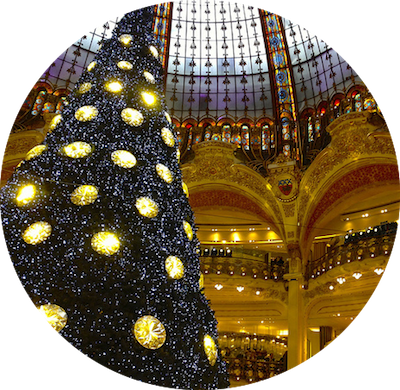A guide to the perfect French Christmas
 Christmas in France is a grand event: a festivity soaked in luxury, splendour and tradition. It’s a time for indulging in rich food, late nights, and champagne. Christmas is typically celebrated on Christmas Eve —le Réveillon— but the entire festive period is magical.
Christmas in France is a grand event: a festivity soaked in luxury, splendour and tradition. It’s a time for indulging in rich food, late nights, and champagne. Christmas is typically celebrated on Christmas Eve —le Réveillon— but the entire festive period is magical.
I love French Christmas traditions so much that I want to share them, so I have put together a guide for creating the perfect French Christmas at home. Joyeux Noël to all of you Francophiles!
Planning a French Christmas feast
Food is the crowning jewel of any Christmas event, and the French are known to eat extravagantly. The Christmas meal in France consists of numerous courses, which are served throughout the evening and sometimes into the night. Although different regions do things differently, the French have some favourites when it comes to planning the Christmas feast.
Oysters are a staple food at Christmas. They may be served as an apéritif with a coupe de champagne, or as part of a seafood platter alongside succulent prawns, buttery whelks and lobster or crab.
Foie gras is typically eaten on spiced bread with onion jam, but can also be served in the form of a verrine, or even as a velvety soup. A sweet wine is often the chosen beverage to accompany this course.
Snails in garlic butter and parsley make another beautiful French starter, either presented in their shells or as part of a cassoulette. Smoked salmon, a delicacy at Christmas time, is loved by the French and eaten either as an apéritif or as an entrée. It’s delicious served on blinis with cream cheese and caviar!
Turkey, goose or capon make the main Christmas meal, stuffed with sausage meat and accompanied by a vast array of vegetables. A cheese board is a must for the French and follows the main course, often including a gooey Camembert, Roquefort and Comté.
Ensuite, dessert – this is usually made up of the traditional bûche de Noël, a sponge cake spread with buttercream and rolled into the shape of a yule log with the aid of a tea-towel.
According to Xavier, a farmer and prize-winning yule log baker from northern France,“the secret behind rolling the perfect bûche is to dampen your tea-towel with a sugar and water solution. This stops the sponge cake from sticking to the towel.”
In Provence it is traditional to serve 13 desserts at Christmas, to represent Jesus and his apostles.
And don’t forget to buy your Galette des Rois at the beginning of January. This traditional cake, made of puff pastry and filled with almond cream, contains a tiny ceramic figurine called a fève. If you find the fève in your slice of cake you will be made king or queen of the day, with your own paper crown!
Decorating à la française
Christmas lights twinkle all over France at Christmas, and some small towns and villages even hold competitions for the most beautiful light display. The sapin de Noël is the centrepiece of the French home at Christmas, and is almost always a real tree, cut down for the occasion.
France’s catholic history is reflected in how the French decorate their homes.
The nativity scene, called la crèche, is arranged in the window or on a table-top in December, but baby Jesus isn’t added until Christmas day. The Advent Wreath, or couronne de l’Avent, is placed in the house, with a candle lit for each of the four Sundays before Christmas.
A flower called l’étoile de Noël is sometimes also used as decoration, and represents the star of Bethlehem that led the three kings to Jesus. The finishing touches are mistletoe and holly, which are hung from the walls.
A French Christmas rooted in tradition
Visiting a Christmas market is essential in the lead-up to Christmas in France. The combination of frosty air, mulled wine and stalls selling artisan goods is the perfect recipe to put you in a festive mood.
The Christmas meal takes place on the evening of 24 December, le Réveillon. Traditionally, small children will put their shoes beneath the fire place or the sapin to be filled by the Père Noël, and presents are often opened at midnight in the presence of the entire family.

Some French families will take a break during the Christmas meal to attend Midnight Mass, usually before dessert. 25 December is a continuation of the festivities, but often with the in-laws.
Jacqueline, a MyFrenchLife™ journalist in Paris, recalls a childhood memory of Christmas: “my most fond French Christmas memory was naturally when I was a child, as both my mother’s and father’s families were from the same town in the south of France. In the morning I would hop from one house to another to open my boxes and we would have a huge family reunion and meal at one of my grandmother’s houses that would last at least three hours.”
French Christmas traditions are plentiful, but you need only adopt some to create an authentic French Christmas celebration in your home. If you are tempted by the idea of children’s shoes beneath the tree, foie gras on spiced bread, or celebrations at midnight, then perhaps a Noël à la française is for you!
Have you been inspired to have your own perfect French Christmas? What are you doing for Christmas this year? Let us know in the comments below!
Image credits:
1. Christmas in Paris, by Bob Hall, via Flickr.
2. Bûche de Noël, By Eric Sonstroem, via Flickr.
3. Couronne de l’Avent blanche, via Wikimedia Commons.
4. Chromo pain d’épices Père Noël, via Wikimedia Commons.








